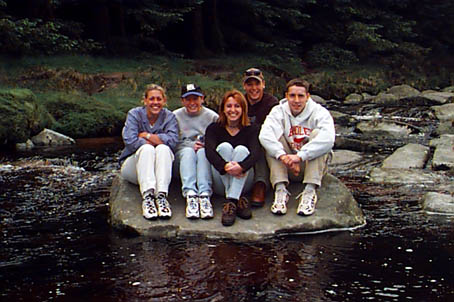
by Kelly Keene
So where did we go today? Good questions. We were going nowhere if we didn't get out of bed. We had nothing to wake us up, as we set the alarm for 6:30, but neglected to check if it was set for a.m. or p.m. Howard shook us loose and we got around real quickly. No one showered, but a little extra deodorant did the trick.
After leaving Dublin, we drove through suburbs and then the start of the empty green rolling Wicklow hills. We first visited the Powerscourt House and Gardens. These were the manor lands of Sir Richard Wingfield, given to him by King James I in 1609. The house was built between 1731 and 1740, and survived until, during a major restoration, it caught fire and burned in 1974. It is in the process of again being restored.
Dublin to Glendalough

|
| During its current restoration, only the gardens and one room of the mansion are open to the public. But the extensive garden pathways and lakes can take hours to visit. |
IThe house is surrounded by large statues and formal gardens. The gardens were designed by Daniel Robertson in 1875. They are considered to be among the finest in Europe. Among the various parts, my personal favorite was the Japanese Gardens. The atmosphere was peaceful, with one little inlet which led into a beautiful little cavern.
At the Gardens, I decided to create one of my "virtual reality" environments. With QuickTime Virtual Reality, you can create a computer file that allows the user to rotate the point of view of an image, as if panning a camera in a complete circle. You can even zoom in and out. For my project, I started at the top of the gardens, by the mansion, and went down into the garden, section by section. I plan on connecting each of these individual VR files into a "multi-node" project in which the user can "click" from one environment to another.
You could spend all day there touring the grounds, but we had to move on to the Powerscourt waterfall. It is 400' tall, the tallest in the British Isles. Because of its scale and the volume of its white noise, a photograph can hardly do it justice. Here is a (silent) movie of our group (556 K) at the waterfall.
Next we hit the road again to climb up a winding, narrow lane to the top of the Sally Gap, or Military Road, through the Gap of Glencree. The drive was terrible; it felt like there were no shocks in the van, or like I was a popcorn kernel exploding in a microwave oven. I'm surprised no one got car sick.
Sheep were everywhere grazing; we even had to stop once so that they could cross the road. These poor animals became the butt of many jokes. The scenery changed from trees and green to barren and brown when we entered the vast boglands of the Sally Gap. We stopped at another waterfall we nicknamed "Guinness" because its color was almost as dark as the brew. Its red-brown hue was due to the minerals and acids flowing from the decaying peat in the bogs that it drains.

|
| We all jumped from rock to rock until we found our way onto a large platform in the center of the rapidly-flowing amber stream. |
Then we hopped back into our van to Glendalough, a monastic settlement begun by St. Kevin in the 6th century. We checked into our neat B & B and headed to the ruins. At one time, during the Dark Ages in Europe, this valley with its two lakes was the center of Western learning. Monks would study there and copy old books, often leaving the monastery and heading out to teach elsewhere on the Continent. There was a 200' tall round tower, which the monks used for storage or as a bell tower. The doorway is 25' off the ground, allowing to monks to escape attacking Vikings in the 9th century by climbing up into their refuge and then pulling the ladder up after them!

|
| The round tower at Glendalough is one of the best-preserved in Ireland. |
It was amazing to think how well preserved these ruins are after so many hundreds of years. This trip has made me really think about the meaning of spans of time. Growing up in the USA, a young country, anything from the 1800's is considered quite old. Here in Europe, something is not considered old unless it is half a millennium in age. After spending a few hours at Glendalough, we ate dinner at the lounge of a nearby pub, then returned to our lodgings for an early bedtime. We have to start out early tomorrow to meet the visiting Peorians in our Sister City of Clonmel.
Back